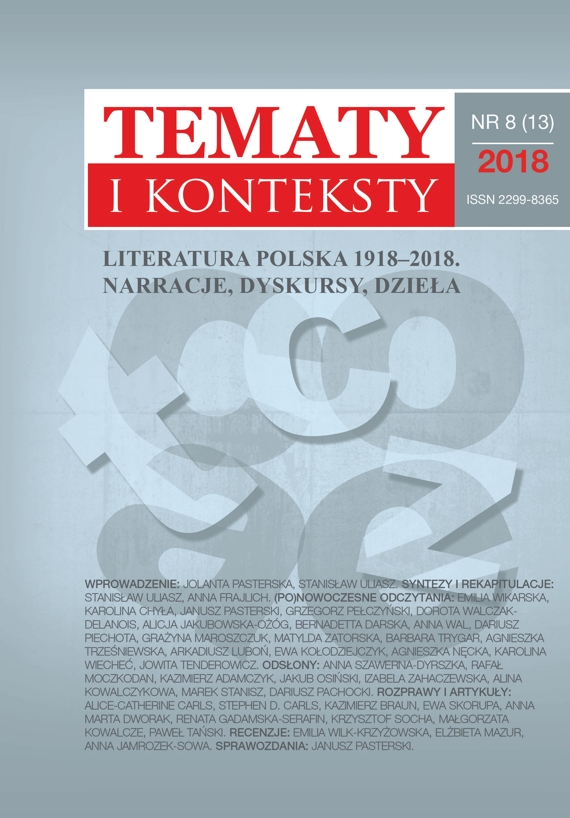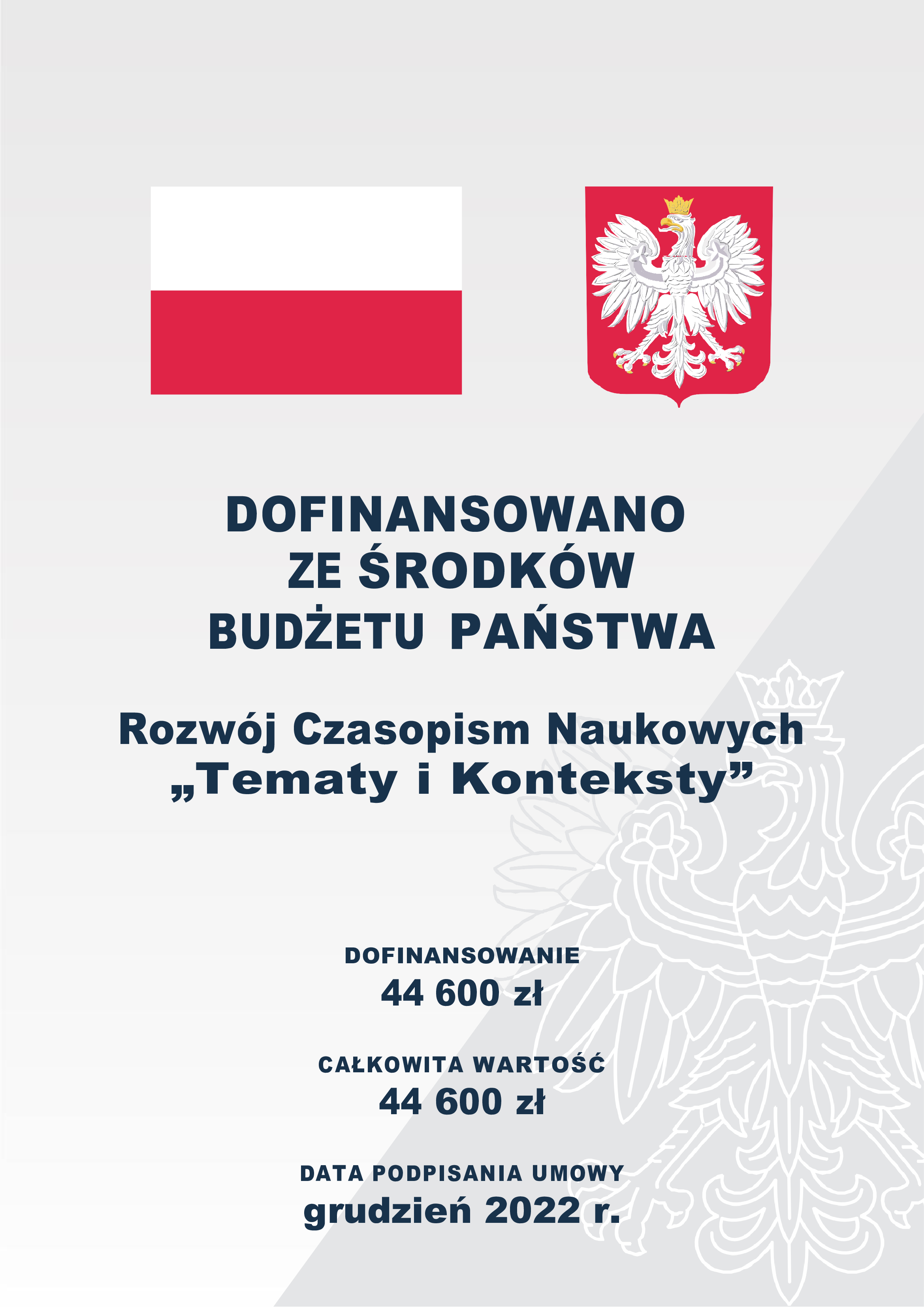„Ja, Ahaswer”. Motyw tułaczki, podróży, pielgrzymowania w trylogii Piotra Bednarskiego Błękitne śniegi i inne rejsy po złote runo
DOI:
https://doi.org/10.15584/tik.2018.11Słowa kluczowe:
Ahaswer (Żyd Wieczny Tułacz), podróż, pielgrzymka, proza autobiograficznaAbstrakt
This article focuses on the topos of Ahaswer (The Wandering Jew) in Piotr Bednarski’s trilogy Błękitne śniegi i inne rejsy po złote runo. The creation of the main character of the series is analysed in the light of the author using the already established scenario provided by culture in the form of a legend of Ahaswer. Bednarski chooses the figure of the Wandering Jew as the one which most aptly reflects the life situation of the protagonist-narrator of the trilogy.
The author emphasises chiefly two aspects of the meaning of the discussed motif in culture. The character of Ashwer is used as synonymous to Jewishness and as a universal representation of the lot of a wanderer.
Downloads
Bibliografia
Bednarski P., Błękitne śniegi i inne rejsy po złote runo, Warszawa 2012.
Buber M., Szukanie w sercu, w: tegoż, Droga człowieka według nauczania chasydów, przeł. G. Zlatkes, Warszawa 2004, s. 11–15.
Chenel À. P., Simarro A. S., Słownik symboli, przeł. M. Boberska, Warszawa 2008.
Chyczyński S., Arcy-dzieło wilka morskiego, „Latarnia Morska” 2007, nr 2 (6).
Dąbrowski M., (Auto)-biografia, czyli próba tożsamości, w: Autobiografizm – przemiany, formy, znaczenia, red. H. Gosk, A. Zieniewicz, Warszawa 2001, s. 48–56.
Filip G., Dziecięcy antykomunizm, „Nowe Książki” 1997, nr 2, s. 28–29.
Gosk H., Bohater swoich czasów. Postać literacka w powojennej prozie polskiej o tematyce współczesnej. Wybrane zagadnienia, Izabelin 2002.
Janion M., Projekt krytyki fantazmatycznej. Szkice o egzystencjach ludzi i duchów, Warszawa 1991.
Kamionka-Straszakowa J., Wstęp do: tejże, Zbłąkany wędrowiec. Z dziejów romantycznej topiki, Wrocław–Kraków 1992, s. 5–30.
Kaniewska B., Między cyklem a powieścią, w: Cykl literacki w Polsce, red. K. Jakowska, B. Olech, K. Sokołowska, Białystok 2001, s. 23–35.
Kopaliński W., Słownik mitów i tradycji kultury, Warszawa 1988.
Kowalski P., Odyseje nasze byle jakie. Droga, przestrzeń i podróżowanie w kulturze współczesnej, Wrocław 2002.
Laing R. D., Podzielone „Ja”. Egzystencjalistyczne studium zdrowia i choroby psychicznej, przeł. M. Karpiński, Poznań 1999.
Lejeune P., Pakt autobiograficzny, przeł. A. Labuda, Autobiografia i historia literatury, przeł. R. Lubas-Bartoszyńska, w: tegoż, Wariacje na temat pewnego paktu. O autobiografii, red. R. Lubas-Bartoszyńska, Kraków 2001, s. 21–92.
Leksykon symboli, oprac. M. Oesterreicher-Mollwo, przeł. J. Prokopiuk, Warszawa 1992.
Leszczyński G., Dzieciństwo utracone. O prozie wspomnieniowej, w: tegoż, Kulturowy obraz dziecka i dzieciństwa w literaturze drugiej połowy XIX i w XX w. Wybrane problemy, Warszawa 2006, s. 374–395.
Makowiecki A. Z., Ahaswer (Żyd Wieczny Tułacz), w: tegoż, 1600 postaci literackich, Warszawa 2011, s. 19–20.
Martuszewska A., Czy marynistyka może stać się kategorią teoretyczno literacką?, w: Problemy polskiej literatury marynistycznej, red. E. Kotarski, Gdańsk 1992, s. 7–27.
Oleś P. K., Psychologia przełomu połowy życia, Lublin 2013.
Orski M., W świecie gorszym niż jaskiniowców, „Przegląd Powszechny” 1997, nr 5, s. 238–240.
Panas W., Topika judajska. Żyd Wieczny Tułacz, w: Słownik literatury polskiej XX wieku, red. A. Brodzka, M. Puchalska, A. Semczuk, A. Sobolewska, E. Szary-Matywiecka, Wrocław–Kraków 1995, s. 1103.
Piotr Bednarski – W czasie, który płynie. Z Piotrem Bednarskim rozmawiała Halina Szczepańska, „Latarnia Morska” 2008, nr 2 (10), http://latarnia-morska.eu/pl/rozmowa-latarni/81-piotr-bednarski (dostęp: 28.10.2017).
Piotrowski W., Legenda o Ahaswerze w literaturze polskiej, Słupsk 1996.
Rabizo-Birek M., Syberyjski apokryf, czyli apostoł Piotr i jego drużyna, „Twórczość” 1997, nr 7, s. 107–109.
Skalska W., Piotr Bednarski „Błękitne śniegi i inne rejsy po złote runo”, Warszawa 2012, s. 365, „Latarnia Morska” 27.04.2012; http://latarnia-morska.eu/index.php?option=com_content&view=article&id=888%3Aqbkitne-niegi-i-inne-rejsy-po-zote-runoq-piotra-bednarskiego&catid=43%3Aiformacje-komunikaty&Itemid=66&lang=pl (dostęp: 8.12.2017).
Theiss W., Tułacze dzieci 1940–1945, w: tegoż, Zniewolone dzieciństwo, Warszawa 1996, s. 33–113.
Tresidder J., Słownik symboli, przeł. B. Stokłosa, Warszawa 2001.
Tuczyński J., Marynistyka polska. Studia i szkice, Poznań 1975.
Ulman A., Powtórka z Hioba, „Rzecz Kołobrzeska” 2004, nr 22 (28.05.2004).
Pobrania
Opublikowane
Jak cytować
Numer
Dział
Licencja
Prawa autorskie (c) 2018 Tematy i Konteksty

Utwór dostępny jest na licencji Creative Commons Uznanie autorstwa – Użycie niekomercyjne – Bez utworów zależnych 4.0 Międzynarodowe.




